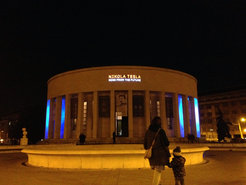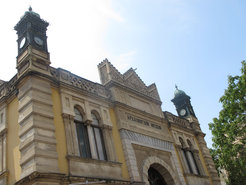Blog | May 2020, The Immanent Frame
space, place
by Jeremy F. Walton
This blog was originally published on 28 February 2020 in The Immanent Frame.

I walk into the mosque. Despite the soaring dome above, the enclosed space intensifies the muggy heat of the late summer day. Approximately one hundred men and boys sit on the hodgepodge of prayer rugs that covers the floor; twenty or thirty women occupy raised platforms to the right and left of the entry, and more crowd the balcony above. Some members of the congregation offer whispered prayers, while others sit subdued, languid. The mosque’s elongated stained-glass windows, each a multicolored arabesque, kaleidoscopically filter the midday sunshine. A paunchy, middle-aged man rises laboriously, stands at the microphone, and begins to intone the ezan, the call to prayer, prior to džuma, the Friday congregational prayer.
* * *
I walk into the mosque. Above, a poster depicts a stylized image of a young man with a well-groomed moustache, probing eyes, low brow, and dark hair; on the façade of the building, a neon sign reads, “Nikola Tesla. Mind from the Future.” Once inside, I pause to pay the entry fee before exploring the exhibition, which combines biographical artifacts, a loose timeline of Tesla’s life, and contemporary sculptures that attempt to render his epiphanies in an artistic medium.

* * *
I walk into the mosque. Two signs create disorientation. The first, in Ottoman Turkish and Italian, offers the date of construction and the architect’s name, Vitaliano Poselli. The second, in Greek, reads “Archaeological Museum.” The interior of the mosque is empty. Several black wooden panels displaying amateurish ink drawings contrast with the original architectural ornamentation of the building, including the mihrab and an elegant calligraphic rendering of the Qur’anic phrase “Bismillahirahmanirahim” in gold leaf paint. My only company that day is outside: a crawl of tortoises wandering between the Hellenic-era tombstones scattered helter-skelter in the courtyard.

* * *
What is a mosque? Most people—and, I suspect, most scholars of religion—would respond to this question with a minimal definition: A mosque is a Muslim house of worship. Those with more familiarity, including most Muslims, might add to this: A masjid typically includes architectural features such as the mihrab, which indicates the qibla (the direction toward Mecca), the minbar or pulpit, and, often, one or more minarets. Some might draw a distinction between congregational mosques, where Friday prayers are held, and smaller sites of worship. As I have hinted by way of my three opening vignettes, however, such a minimal definition of a mosque belies complexities of history, demography, and political context. I will expand on the three vignettes, drawn from my research in the Balkans, below. First, however, I would like to pursue the question of a mosque’s definition in light of the overarching themes of this essay: the relationship between the concepts of space and place and the implications of the space/place dichotomy for the study of religion.
Despite the recent “spatial turn” in the humanities and social sciences, scholarship on religion has remained unattuned to the concepts of space and place. I suspect that the reason for this neglect is rooted in a long disciplinary hangover following the rejection of both phenomenological and functionalist concepts of “sacred space.” Nevertheless, this inattention to space and place in the contemporary study of religion represents a missed opportunity, particularly at a time in which the relationship among theologies, communities, and sites of worship is increasingly disaggregated.
Generally, we can distinguish three broad flavors of the “spatial turn”: 1) phenomenological approaches to spatiality, rooted in the philosophy of Martin Heidegger, Maurice Merleau-Ponty, and Gaston Bachelard; 2) post-structuralist and Marxist perspectives on space and place stemming respectively from the work of Michel de Certeau and Henri Lefebvre; and, 3) postmodernist deconstructions of spatial continuity and homogeneity. While a more general airing of the resonances and dissonances among these three strands in “space theory” is a worthy pursuit, it is far beyond my confines here. Rather, in order to illuminate the three mosques that I entered at the outset of the essay, I lean on the distinction between space and place offered by de Certeau: “Space is a practiced place. Thus the street geometrically defined by urban planning is transformed into a space by walkers.” To paraphrase de Certeau, we might say that places are objective abstractions, while spaces are subjective sites and crucibles of experience. The potential applications of this distinction for the study of religion are myriad. Familiar sites of religious worship—mosques, mandirs, synagogues, temples, gurdwaras, churches, and shrines of all sorts—may share commonalities as places, yet differ radically as spaces. And it is at the level of spatial specificity that history, memory, and practice achieve texture and depth.
* * *
In the first vignette of this essay, I joined worshippers for Friday prayer in August 2019 at the Ferhadija Mosque in Banja Luka, the capital of Republika Srpska, the semi-autonomous Bosnian Serb political entity within of Bosnia-Herzegovina. Architecturally, Ferhadija is reminiscent of other sixteenth-century Ottoman mosques, inspired by the genius of Mimar Sinan, but as a structure it is quite new: The original mosque was demolished by Bosnian Serb forces in 1993, during the war, and the reconstruction was only completed in 2016. Yet my attention on that day was drawn to the congregation rather than the structure.
In the second vignette, which took place in November 2017, I ventured into an exhibition space in Zagreb, Croatia. The neoclassical-modernist structure, officially named the Meštrović Pavilion, was originally designed as an art pavilion by the famous artist Ivan Meštrović in 1938, but was converted into a mosque during World War II in a cynical attempt by the leaders of the fascist Independent State of Croatia to court Muslims as political allies. Although it functioned as a mosque for less than four years, it remains colloquially known as “džamija” (mosque) today.
In the third vignette, from Summer 2014, I visited the New Mosque (Yeni Camii/Geni Tzami) in Thessaloniki, Greece, a striking building that unites neo-Moorish and Art Nouveau elements. During the late Ottoman era, the New Mosque catered to the city’s affluent, syncretic, and secretive dönme community. During the population exchange between Greece and the newly-founded Turkish Republic in 1923, the dönme were forcibly relocated. Their former mosque served as the municipal archaeological museum before becoming an occasional exhibition space, even as it has also been recruited to new romances of multicultural tolerance among communities and religions.
* * *
Are each of these sites mosques? They are referred to as such, and, as places, they share basic architectural qualities and original institutional functions. As spaces, however, such commonalities yield to a welter of stories, histories, and experiential thicknesses. Space and place encourage contrary, but not incommensurable, perspectives. By shuttling between the orders of place and space, we might pioneer new perspectives on the spatialities of religion. Doing so necessarily carries us beyond the comforting, reductive distinctions—sacred and profane; public and private; religious and secular—that typically orient research on religion. For it is precisely in the variegated textures, embedded genealogies, and palimpsests of practice—what I have elsewhere called the “textured historicity” of spaces—that more panoramic and microscopic visions of religion await.













